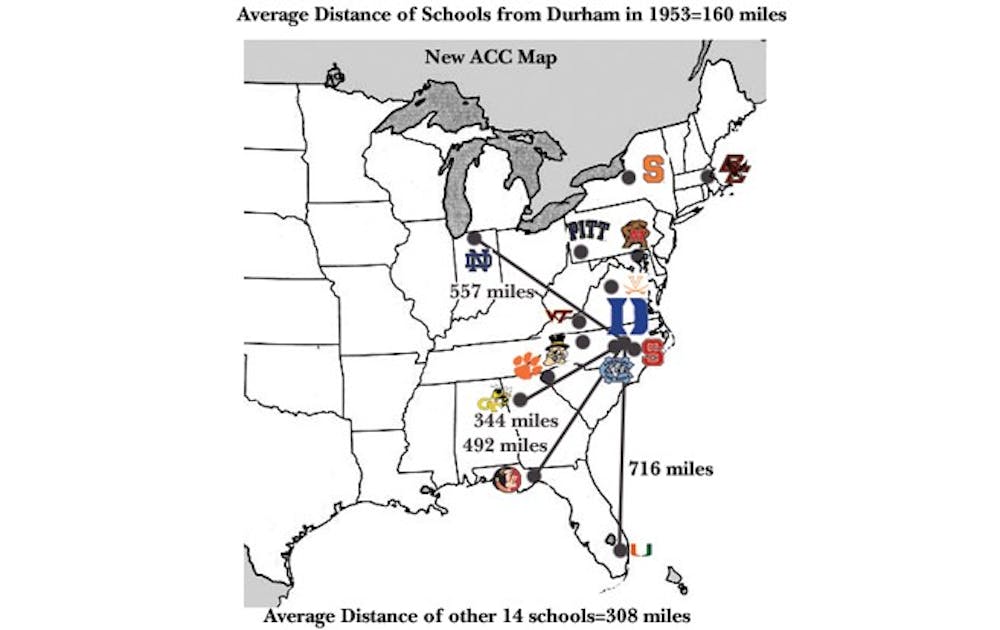If you read through the various media coverage of the news that Notre Dame has agreed to join the ACC, you might wonder if you were reading a story about Russia joining NATO.
Duke president Richard Brodhead praised Notre Dame for its “excellence in academics, strong traditions in athletics and international recognition.” Kevin White, Duke vice president and director of athletics, echoed those sentiments almost word for word and added that Notre Dame’s entry to the conference is “just another highly visible sign of the strength of the ACC, and both the vision and leadership exhibited by Commissioner [John] Swofford.”
“Around the ACC,” wrote The Chicago Tribune’s David Haugh, “athletic officials understandably spent the day admiring [the announcement].” And the rest of the media had a field day with the conference’s talking points as well, especially the increased stature and leverage for the conference in negotiations for television contracts and bowl placements.
All of that is wonderful and laudable, and indeed it’s hard to argue that the move won’t be beneficial for the conference, both in terms of revenue and competition for fans to enjoy.
It seems to me, though, that there’s a big group of people missing from all this praise and positivity—the athletes themselves. And I’m not talking about the elite basketball and football players, many of whom made their college choices based on the ability to get national exposure to professional teams. But we’ve all seen the NCAA ads about how many athletes are “going pro in something other than sports.” Does this move help them?
I’m not so sure. I don’t speak for anyone on any varsity athletic team, but I don’t imagine most athletes, who work harder than just about anyone on this campus to balance intense athletic schedules with typical academic demands, care that much about “the strength of the ACC” or “the vision and leadership” of John Swofford. Having Notre Dame’s “international recognition” in the conference isn’t helping them get a job at the end of four years or have a normal social life outside of two-a-days. Most of the columnists writing about the news entirely glossed over the fact that the move affects thousands of athletes across varsity teams in dozens of different sports, not just ones who play in front of 50,000 fans 12 times a year.
I’ve traveled a fair amount for The Chronicle covering various Duke sporting events, and while I’ve loved every second of it and been privileged to get to do it, there comes a time when another day trip to Boston College can become a chore rather than an exciting novelty. You miss class, you miss work, and you spend a lot of time traveling and sleeping in hotel rooms. And Duke’s athletes are doing this far more frequently than I do.
When the Atlantic Coast Conference was created in 1953, the average distance from Duke to the other seven conference schools was about 160 miles, in a conference centered around Tobacco Road. When Georgia Tech entered in 1979, it was 100 miles farther from Durham than any other ACC member at the time. Florida State joined the conference in 1991, 250 miles farther than Georgia Tech. Miami, a 2004 entrant, is nearly 200 miles farther than Tallahassee.
And with the latest expansion, including Pittsburgh, Syracuse and Notre Dame, the average travel distance from Durham to the other teams in the conference is nearly 380 miles, more than double the average distance as recently as 20 years ago. The current ACC seal bears a map stretching from Florida to New York, with stars at the location of each member school, and South Bend is well off the map.
It’s not as big of a deal for the football and basketball teams, who are used to playing national schedules and charter expensive private aircraft on their own particular schedules. The non-revenue sports teams are taking long bus rides or flying commercially, with all the connections and flight delays that entails.
Don’t read me wrong—I’m not trying to suggest that the ACC should have just stood idly by with eight tightly-clustered schools as the rest of the conferences in the country realigned with dollar signs in their eyes. From a fan’s and journalist’s perspective, Notre Dame will be a fantastic addition to the ACC, and the extra revenue that each member school will get should benefit all student-athletes in one way or another.
I just think it’s important that we recognize the changes for what they are—a play by athletic officials, not by athletes, for ever-growing pots of television and media revenue in a very few select sports. Conference realignment is far from over, and as schools continue to make power plays for prestige and revenue, the concept of the true student-athlete (notice student comes first) could continue to take a beating.
I would never want to begrudge the athletes and coaches in revenue sports their national exposure or their increased ability to bring their schools multi-million-dollar windfalls, because they’ve worked hard to earn those privileges.
I just hope that through continuing change, the vast majority of athletes can still reasonably hope for four-year commitments to going pro in chemistry or public policy. Their successes may not result in nine-figure checks signed by ESPN, but are worth every bit as much.
Get The Chronicle straight to your inbox
Signup for our weekly newsletter. Cancel at any time.

